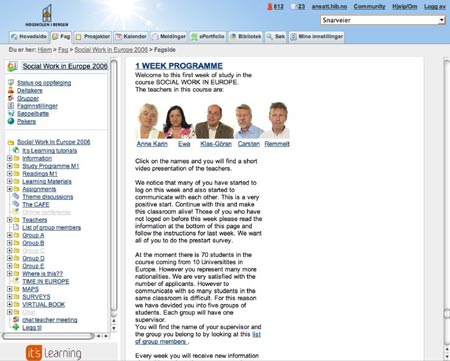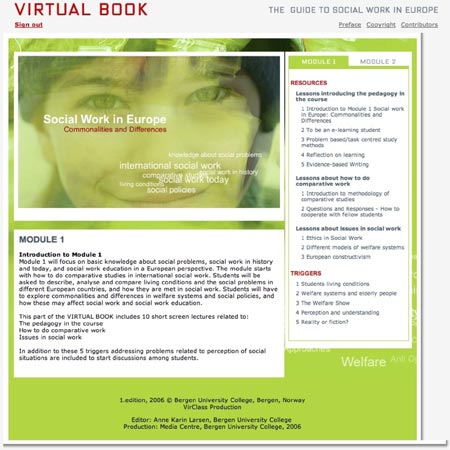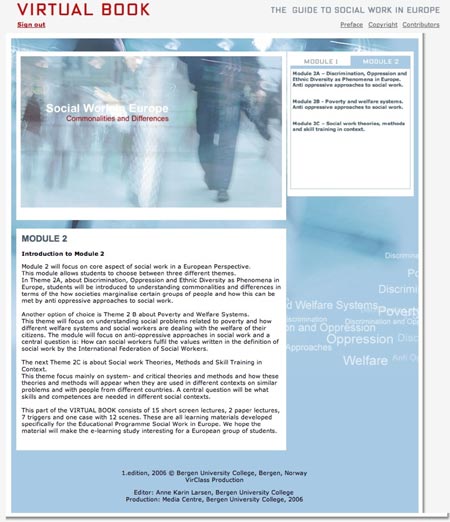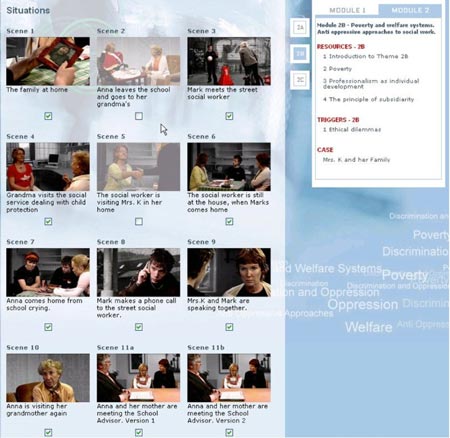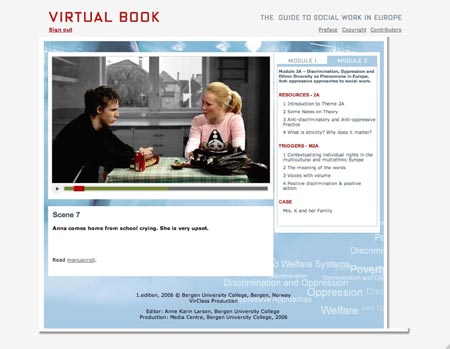Developing a Virtual Book - Material for Virtual Learning Environments
Anne Karin Larsen (1)
Assistant Professor, Project LeaderBergen University College
Email: anne.larsen@hib.no
Grete Oline Hole (2)
Associate Professor,
Bergen University College
Email: goh@hib.no
Morten Fahlvik (3)
Project Leader, The Media Centre,
Bergen University College
Email: mfa@hib.no
Abstract
This article describes the process of, and considerations taken when Virtual Learning Materials were developed for an international study in Comparative Social Work arranged by the VIRCLASS project. The steps taken and the elements included in the Virtual Book – A Guide to Social Work in Europe are presented in details to inform others who are planning to make virtual learning materials. Students from 11 countries in Europe participated, and their reception of this material and learning outcomes from using it are analysed and presented. Furthermore; the article discuss how the learning material contributes to students’ learning, how a common understanding of practice enhances knowledge-building and in what way audio-visual learning material can contribute to good learning in e-learning courses. The results are discussed in relation to theories about composite texts and community of inquiry, and outlines some challenges for e-teachers’ competences.
Introduction
This article will present some experiences drawn when developing and using a Virtual Book and discuss what consequences virtual elements like this may have for e-learning and for students in social work. What are the students’ experiences in relation to learning and learning outcomes? What works or does not work?
The idea of developing a Virtual Book with learning materials came as a result of running an international e-learning course with students and teachers from all over Europe. The course: Social Work in Europe – Commonalities and Differences, is a result of the VIRCLASS project – The Virtual Classroom for Social Work in Europe1 (www.virclass.net). Development and learning outcomes from this project have been analysed and described elsewhere (Hole & Larsen, 2007; Larsen & Hole, 2007a; Larsen & Hole, 2007b).
After analysing the experiences of the students and teachers from the first pilot-course, we noticed that students had appreciated the use of a short video case (video of a single mother with low economy) presented in one of the modules. The positive reaction to this amateur video made us reflect over how to increase the audio-visual elements in this international course. Inspired by other projects (Glad & Lekven, 2007) and knowing that Bergen University College (HiB) had a Media Centre that was competent to do the job, an application for grants was sent to Norway Opening Universities (NUV); and the production started in 2006 after the grant was approved.
Pedagogy and learning objectives
VIRCLASS is funded on a socio-cultural learning perspective intending to develop a community of learning among students from different parts of Europe (Wenger, 1998; Larsen & Hole, 2007b). Study of social work in their own country and participation in the VIRCLASS courses will give students an opportunity to look at commonalities and differences and compare their knowledge and practice to that of students in other countries by participating in theme discussions, chats and by sharing documents. The courses intend to stimulate creativity in problem-solving processes as an important part of the daily work of a social worker. Through interaction between students from different countries working with the same assignments in a transparent classroom, we hope to stimulate new methods of problem-solving strategies in social work. More details about learning objectives can be found in the Curriculum Plan (www.virclass.net).
High commitment and engagement from an international group of teachers and partner institutions involved in the project has been of significant importance both for the development of a common curriculum plan and the virtual learning material, the collaboration among teachers running the courses together as well as the development of an administrative model for the partner institutions constituting a Consortium. Production of short screen lectures and other audiovisual learning material have made the teachers aware of the important differences in the e-teacher role compared with the campus teacher (Larsen et al. submitted).
One of the main challenges in Open Distance Learning (ODL) is to get the students to communicate and collaborate (Salmon, 2004; Paulsen, 2007).
A major idea in our courses is to stimulate international cooperation in the learning process and VIRCLASS has high ambitions towards making this possible. This ambition meets some barriers because of students’ different time schedule, different holidays and times for exam as well as time spent on courses at their home University (Larsen & Hole, 2007b).
The idea of bringing more audio-visual elements into the course is supported by cognitive psychology and theories about perception. The human processing of the different visual elements (pictures or film) can trigger learning in different ways (Helstrup & Kaufmann, 2000), as well as supporting the students’ various learning styles (Gardner, 1993). Visual information can be two-dimensional (pictures) or three-dimensional (movies, videos, flash-productions). Learning as development of competencies is closely related to the interrelationship between content, motive power and interplay or cooperation between the individual and the society (Illeris, 2006).
As e-learning courses become more common, it is important to know more about what causes good learning in computer-supported settings (Ludvigsen et al, 2003; Kuomi 2006). Careful considerations were taken in the production of this material, as shown in the following paragraphs.
Production strategies and methods
Four basic considerations were taken before starting the production of the Virtual Book. Firstly, it should be possible to use the product independently of any standard Virtual Learning Environments (VLE) or within different VLE systems. Secondly, we wanted to be able to use the display without being tied to the frames of any specific VLE interface. Thirdly, we wanted to exploit the multimedia possibilities in e-learning and promote student activity and interaction. Finally we wanted to produce a material that could be reused in the course year after year; thus leaving more time for supervision, communication and responding to students’ assignments.
Cooperation among the partners involved has been an important part of this production. The decisions regarding elements and content of the Virtual Book have been taken together with the international e-teacher group and the Media Centre, starting with what elements should be included, the graphic design or wrapping, construction of lectures, audiovisual triggers and a manuscript for a video case. The project leader for VIRCLASS was responsible for the professional content and served as editor (Larsen, 2006), while the production leader at the Media Centre coordinated the staff involved in the production. There was one producer of the video elements and one graphic designer for the whole production. This division of responsibility for different tasks has been very important and facilitated good and effective cooperation. The Virtual Book has been in development for more than one year. The combination of pedagogical and technical competence, experience with e-learning pedagogy and production of digital learning materials contributed by the Media Centre at HiB was highly appreciated by the social work teachers and European partners. The process includes the translation of different professional concepts and language into visual and technical meaningful expressions. The quality control, including the permission to use others’ material, was taken care of by the editor and the producers.
Design is not only an ornament, but also serves to underline the content. Design can have a significant effect on how we make meta-cognitive decisions and the layout can affect work-flow (Kirsh, 2005). The chosen interface gives associations to peoples’ everyday life, where their ordinary human problems very often are invisible to their surroundings. With the Virtual Book the designer
2 wanted to bring students into a different atmosphere than that of the standard VLE and to give them an opportunity to capture a special modus and other “view” when looking at a problem.
The Virtual Book is published in a custom-made web publishing solution made by the Media Centre and contains learning objects like texts, animations (triggers), video-lectures, video-clips with scenes from a role play of an immigrant family. Each learning object in the Virtual Book has a unique address which gives the teachers the possibility to make a direct reference from an assignment to a specific learning object. It is easy to update and add more content to the Virtual Book. When students are logged in to the Virtual Book they will have access to most of the material. An exception is made for the video-case where the e-teachers can decide when and which scenes students are allowed to view depending on the progress in the programme. The main idea behind this choice was to let the Virtual Book appear as a printed book where all the pages are always present and accessible. This will hopefully motivate the students to explore the content and make them curious about the whole study program.
The unique addresses to the learning objects allow the e-teacher to utilize the learning objects in a wide variety of activities. The book contains material the teachers can include in tasks, but the tasks themselves are presented outside the Virtual Book, which makes it possible to use the material in different ways, according to one’s didactical approaches.
Few students starting at VIRCLASS have had any prior experience with e-learning, and it was important not to exclude any applicants due to technical equipment and software demands. Starting the production of the Virtual Book in 2006, we kept this in mind and chose to use the Flash plug-in for visual elements, which is easy to download. However, we were aware that the sound and video elements would function best with a broadband connection.
It was decided that the VLE should take care of the course-administrative part of the programme while the Virtual Book should include learning material such as screen lectures, triggers and a video case. The VLE included the bulletins, discussions, chat, messages, personal presentations, information about the curriculum, literature, weekly programmes, assignments, open feedback, surveys, e-portfolio and exam delivery. We wanted the students to be met by their e-teachers immediately upon entering the bulletin board in the platform; and as such the personal video presentation and welcome from each of the e-teachers was included in the VLE and not in the Virtual Book (Illustration 2). A shared log-in page for the Virtual Book and its learning was made (Illustration 1).
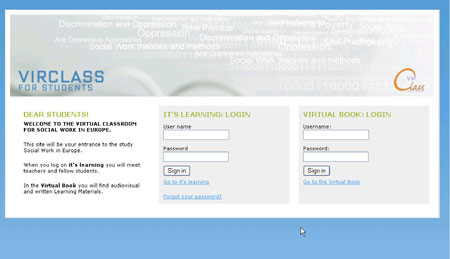
Illustration 1: A shared log-in page
The Virtual Book is password protected and only available for students and teachers participating in the courses. We did not want students to have access to the material before they started the course. We wanted to take care of their first impression of the triggers and the case.
Illustration 2: The it’s learning course page, Module 1
Production of the specific content in the Virtual Book
The Virtual Book is constructed in two parts (Illustrations 3 and 4). One part is for the content in the Module 1 course, the other for the content in Module 2 with separate “chapters” for the three themes in that module3 . Each part and “chapter” is subdivided into resources (including the screen lectures), triggers, and the case (only in Module 2). There is a preface, information about copyright and an overview of contributors. Each module and theme has a short text introducing the content.
Illustration 3: The different interfaces in the two parts of the “book”. Module 1
Illustration 4: The different interfaces in the two parts of the “book”.
Module 2
The Virtual Book includes 25 screen lectures, 12 audio-visual triggers and a video case containing 12 scenes. All elements have a text file, produced as a .html or .pdf file, which can be downloaded separately. A list of content can be seen in Appendix 1. A promotional video is available at
www.virclass.net/virtualbook/promo.html (Illustration 5)

Illustration 5: The promotional video (click on the picture to see the video)
The lectures were produced as screen lectures of 15-20 minutes. We considered well-tailored short lectures to be better than more traditional ¾ hour lectures with a PowerPoint presentation (Kjeldsen, 2005; McGrann, 2006). Applying a student perspective to the receiver's end, we decided to use the television format where the picture of the person on the screen and other elements are shifting; what Kuomi (2006:95) calls screenwriting, with words and pictures being carefully interwoven (Illustration 6). The lectures were recorded in HIB’s studio in Bergen, with the international group of professors presenting their lectures in English. Understanding the implications of making lectures in this genre was a great challenge due both to time limitation, video recording and language for the teachers.
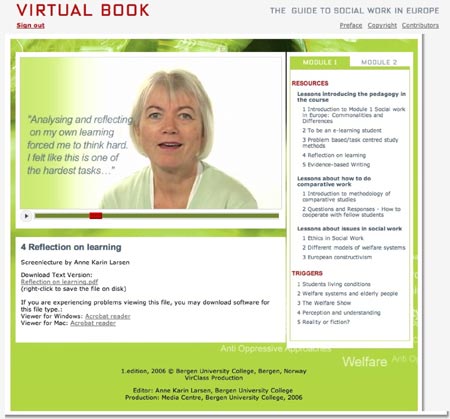
Illustration 6: Example of the interface of a screen lecture
Triggers are visual or audio-visual elements like pictures or flash productions, which aimed at stimulating curiosity, perception and fantasy (Illustration 7). The triggers were related to a task or some questions, and students were asked to share their interpretations or thoughts in a theme discussion after looking at the triggers. They were challenged to discuss their different interpretations, and to see whether they could relate the visual elements to their professional work. The content of the triggers came from the professors after brainstorming sessions in meetings, and were related to the content of the particular modules and themes. The triggers were produced according to a standard format including: situation/issues to address, objectives, content, participants, medium, and which module or theme it should be related to.
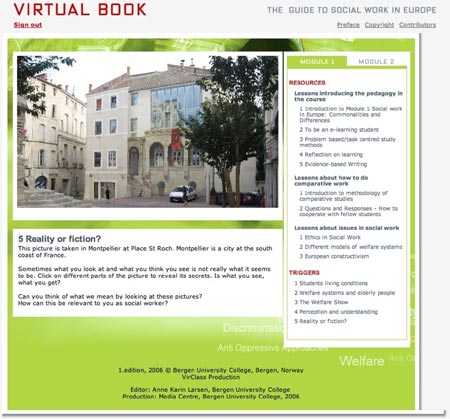
Illustration 7: Example of a trigger 4
A trigger many students found interesting. (Click on the picture to open the link and follow the instructions in the text)
The video case illustrates a single-parent immigrant family from Belarus living somewhere in Europe (wherever the student comes from). The twelve scenes (Illustration 8 and 9) give short glimpses into the family’s life in different situations and locations, and their meetings with social workers in various settings. The case was intended to give students a chance to relate theory to practice, and represent a shared starting point for discussions, professional description, analysis, intervention, and comparative work with a task-centred approach (Skaar, 2005). Snapshots from the case can be seen in the promotional video (Illustration 5).
Illustration 8 and 9: Overview of the scenes from the case, and one of the scenes
Illustration 8. The teachers decide which of the case situations students are able to see. Scenes faded out are not available to the students, but they can see that there is more to come.
Illustration 9 One of the scenes
The manuscript and the characters were made in a brainstorming session where all project partners participated and finalised by a few of them. One professional actor and several amateurs and colleagues from HiB were hired to participate in the role play. For economical reasons a blue-screen studio
5 was used for production. Pictures of different locations and surroundings were taken, and purposefully presented in black and white in order to make a more “anonymous” background and not take the focus away from the actors (Illustration 10). Props were rented from the Salvation Army second-hand shop. Three cameras were used to record and the scenes were edited in studio while recording, the process of which took 14 hours. The final editing job was done later, whereupon sound effects were added to the video. In addition to the actors, four people were involved in directing this production.
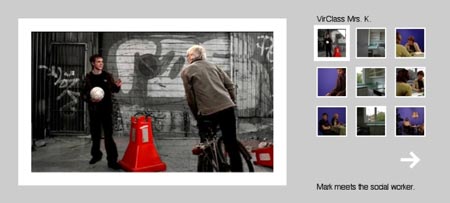
Illustration 10: The blue-screen method. (click the picture to see how it works)
Evaluation of the learning outcomes from using the Virtual Book
After producing this learning material we wanted to know what consequences did virtual elements – like the introduction of a Virtual Book – have on e-learning for students in social work. What did students experience as productive for their learning and what did not work in relation to learning?
Research method
This research and the data analysis are inspired by pragmatism (Creswell 2007:22; Cherryholmes, 1999); no specific philosophy or any particular theory structures the data collection and the analysis. The purpose of the data collection is evaluation research (Patton, 1990), and the collection is based on a triangulation of qualitative and quantitative data. To explore whether the learning objectives were met we extracted the students’ learning experiences from using the “book”. Two surveys have been done after the end of the two modules - including questions with multiple choices, open- and closed response alternatives - collecting information about students’ experiences with the material. Qualitative telephone interviews with six students from different countries who participated in different themes in module 2 were done before the end of Module 2. In addition to this there is data from students’ opinions about the triggers presented in theme discussion in module 1.
Together with the data collected from the students, a survey and a group interview of the teachers was done after module 2/2007 as well as a group interview with the producers in Spring 2007.
In the following session data from the student surveys and the interview with 6 (out of 24) students from different countries who participated in Module 2 (2 students participating in each of the three themes in this module) will be presented. The interview was carried out in English for 4 of them, and in “Nordic” for 2 of them. After the analysis of the interviews six categories emerged:
Contact : seeing the teachers, working with other students, the feeling of participating in a class.
Content: includes comments to different parts of the book such as screen lectures, the triggers, the case, or the .pdf files that have been important for learning.
The book as a concept: comments on lay-out, structure, availability, usability and access.
Technology: how the technology worked; whether technology provided learning or not.
Study level: students’ experience with the content and learning material – whether it was too advanced, too elementary or it suited their level.
Learning outcomes: Students’ summary of their learning experience and how they felt the learning material had contributed to new practice.
Both the surveys were delivered in it’s learning (the VLE used for the courses) and the survey after Module 1 focused on triggers and lectures; while the survey after module 2 focused on all the elements, including the case. The interview focused on whether the Virtual Book had contributed to learning or not. The analysis of the surveys has been done in the same way as that of the case, focusing on what “works”, “does not work” or “contributes to learning”? The open-ended questions have been cross-case analysed (Patton, 1990:376) by analysing all the responses to specific questions.
What may affect this research is the writers’ very close relation to and knowledge of the course. The first writer is the project leader for and editor of this Virtual Book and is using the learning resources as a teacher in both modules. To avoid possible bias, the validation of the research process has been handled by data triangulation and by inviting a fellow researcher (the second author) to join the data analysis. The surveys have been developed and refined in cooperation with VIRCLASS research, some of the partners in the project.
The way the students used the material
In the survey after the end of Module 1, most of the students (N=36, n=33) reported that they had both seen and read all the screen lectures. 1/3 of the students seem to have preferred reading the lectures. Very few (6%) reported technical problems. Two lectures were not seen or read by 12%. Most students found the lectures informative, relevant, clear and interesting, and stimulating to their work. Students found the triggers interesting and the different triggers in Module 1 had been viewed by about 80-95% of the students.
In the survey after the end of Module 2 students participating in the different themes (n=20) 6 were asked what they had viewed in the Virtual Book, relating both to their own theme and the other material in the “book”.

Table 1 Material seen by students
Table 1 shows the percentage of students looking at the different material in their theme, and how many had been looking into material in the other themes. The case is similar for all three themes in Module 2 but only open to students for the theme they are studying. Nobody had viewed all the material in the Virtual Book. Some few students in Module 2B and 2C reported that they had technical problems with viewing the video material and had only read the text files.
What students find helpful or not in terms of learning by using the Virtual Book
About the content
Students found the content, including the different parts of the book: the screen lectures, the triggers, the case and the .pdf files, important for their learning.
The screen lectures were important when writing and responding to the assignments.
“The Virtual, clear and precise lessons allow to understand in a better way the meanings of the work. They gave me useful advice from a theoretical point of view but they were also fundamental for the realization of the tasks. Thanks to the fact that they have always been available on-line without limits of times I could organize my work more easily in relation with my study or work schedules” (survey M1/2006).
Students found the lectures introducing the themes, lectures about working methods and lectures directly related to specific assignments most helpful.
“It was really nice the introduction – important for the students first time they become an e-learner, and it was really useful – and also the theories regarding subjects. At this time in module 2 we had to compare the themes in the case and it is more concrete, not so theoretical. But it was useful – I have the basis from module 1” (S37 interview 2007).Students with technical problems did not manage to view the videos and for these students especially, the text files with the lectures were important. The text files were used in different ways, some printed the text and followed the text while viewing and listening to the lectures, others printed the text files later and found it easier to look at the paper version when they were searching for information they needed. Some did not print the text at all, but just viewed it on their monitor.
The triggers have been important for students’ reflection and learning. In the surveys and the interviews, students confirm that the triggers stimulated their learning in many ways. They were inspiring, and led to thinking about social work from another perspective; and they liked to see how other students had interpreted the material. The triggers were also a great reminder of aspects they already knew but had forgotten:
“It stimulates me to think about how I look at things. Sometimes your first impression is not correct”.“They made me stop for a little while and think over a few facts of social work. It was useful for my attitude to the profession and my further professionalisation” (survey M1/2006). Some of the students did not see the triggers because of other priorities:
“I have not seen them as priorities since I have had a lack of time. Therefore I have not been able to read many of the other students’ reflections. I also think there are a bit too many triggers (survey M1/2006). The video case raised problems that students found very realistic; some experienced that the family situation in the case illustrated a situation they might encounter, or even that it resembled one they had been working with in their practice.
“I think it is a case that we can be confronted with at any time in real life. It’s a very realistic case to work with” (S4 interview 2007). By not giving students the possibility to see all the scenes at once, the teachers kept the students alert, and stimulated their curiosity for what was going to happen next:
“…it made me want to see more every time” (survey M2/2007).
At the end of the course, students could see the whole case.
The fact that there is a video with real people makes a difference to students’ way of learning.
“I really like seeing people. Because we are used to working with cases in our study, but it is different to actually see the people you are talking about. Then you also can see their non verbal communication and you hear what they are saying. Because when we get the printed cases there are no words spoken in it, just information. So this is different. And I like this way of working, because this is more like real life. So if you are a social worker coming to MRS K’s family you would see them interacting, behaving like in a movie and you wouldn’t just read MRS K is 42 years old..” (S5 interview 2007).
The case gave students situations they could compare to situations in other countries, which is the main objective in the curriculum plan for the courses.
“What I really liked about this case is that we have to compare and imagine that she is someone in our country. And then we have to find our own sources and that is really something interesting because in that way you can compare the situation for immigrants in different European countries. I did not realize the difference it caused being an immigrant in Holland or in Sweden” (S5 interview 2007).
About contact
The work related to the triggers was often reflections upon or interpretations of the triggers, presented by the students in the theme discussion area in the platform (it’s learning). Both the triggers and the video case contributed to contact, and a feeling of being part of a real classroom:
“I was hoping that we had more triggers in module 2 as well… It is not so much work connected to it, but it helps to stay in contact with the other students as well, and in this module, I was missing this contact with the other students a little bit” (S4 interview 2007).“The case is an important instrument for working and learning - the working group discussions about the theme – this is the real meaning of cooperation, it did not matter that we were far away” (survey M2/2007). Students experienced that the material gave a sense of being in contact with other students and teachers, and of participating in a real class. They knew that they were looking at the same material, getting to know the same immigrant family and looking at the same triggers; and this gave them a feeling of being in the same community of learning. Additionally, the teachers’ personal presentations in the beginning of the course were important for this feeling of being in contact.
“What I really liked in the beginning of the course in 2006 was seeing the teachers, actually seeing them, much nicer than just reading a text they had written. It gave me a feeling of going to a real class. The difference is that you cannot ask any questions and there is no direct interaction. But I like the idea of presenting the teachers by showing them” (S5 interview 2007).
About learning outcomes All the students found the case important to their learning, and thought module 2, which included the case, to be more interesting than module 1. The opportunities to relate theory to practice and to actually see people, hear them talk, notice their feelings and emotions; all this made a great difference to their learning process. Some students experienced working with a “real” case, and being able to think in a concrete way about different ways of interventions, for the first time. The case made some students aware of different roles or working arenas for social workers, which they had not been familiar with in their own country (like the street social worker).
“It has contributed much to my learning, because the best way to learn the things is by doing practice and examples, and also I really like the transparency8 to see the different solutions” (survey M2/2007). The case stimulated their knowledge and their search for information about problems in the case:
“The case makes me curious and starts me thinking and connects theory and practice in a way that I probably would not have done without it. And I search for information and collect knowledge that I might not have done otherwise. I notice that it makes me develop personally”(S2 interview 2007). The case also challenged the methods of interventions and the skills needed for working with the family:
“To look at all the problems in one family. You did not know how to start, which person to start with, how to approach the family” (S4 interview 2007).
About the “book” concept Students felt the concept to be good, and were impressed that so much work had been put into making the course interesting. Students interviewed were asked how the material if not existing would have affected their participation in the Virtual Classroom. This expression from one of the students is an example of what others responded:
“Without the book? Oh, the course had been less interesting. I participated earlier in a course on the internet and it was dull. This one gives me a lot more. The virtual material makes the course fun. It would have been good anyway, but this material adds an extra dimension” (S1 interview 2007).
How did the material meet the students’ educational level?
Both Second year BA students, MA and PhD students, and professional social workers participated in the courses and it is interesting to see how their educational level was met by the content of the book and the course. When interviewing the 6 students about how the lectures in the Virtual Book had met their educational level, they all responded that the lectures suited their level. This does not mean that they were simple; students found them stimulating, interesting and it gave them new perspectives:
“The lectures suit me well. They fit very well together with the literature. If they were more advanced, then it will not be so interesting to read. It’s a good level. The lectures make me want to read. I can be rather tired but when I look at lectures it inspires me to read more” (S1, interview 2007).
What did not contribute to students’ learning?
Students did not have many negative comments to the Virtual Book, but some had technical troubles that caused problems using the audio-visual material, either due to slow Internet connection or because of other computer problems. These students found the material useful by looking at the pictures and then reading the text files, but they could not see or hear the video properly. The text files seem to have been useful to all the students.
“..when watching the lectures with Linux there was delay between the sound and the picture which is very annoying at times, especially if the teacher has an accent I am not used to?. Makes it more difficult to follow when I can’t read the lips too.. “(student survey M1/2006).
Most of the students expressed that the length of the screen lectures was fine; a few thought some of them could be shorter. A few mentioned there could be more lectures. Some students would have liked more triggers available, because they triggered discussions among the students and formed a common ground for discussions.
E-teachers’ reflections about the learning materials’ effect on learning and teaching
All the professors except one had participated twice (2005 and 2006/07) as e-teachers in VIRCLASS courses. This time all of them found the course a very good and satisfying experience due to the new learning material, and better knowledge of the platform. They felt more confident with both the content of the courses they taught, and the technical challenges of being an e-teacher.
“The best experience for me was the improvement the Virtual Book turned out to be”.”This works for students as well as for teachers!!” (teacher survey 2007).
Use of the Virtual Book changed the job as e-teacher; having all the learning material already available reduced stress, and they could spend more time supervising students’ work and communicating with them in chats or theme discussions.
“Virtual Book has been central to the new way teachers have worked this year. It permits teachers to centre their efforts in the tutorial tasks. Also to the students it helps to increase their motivation and it contributes to reinforce the perception of the quality and seriousness of the courses offered” (teacher survey 2007).
The Virtual Book did not only make the job “easier” for the e-teachers, but it also motivated students and was a vital component in the Educational Programme:
“The virtual book was very good to motivate students, to give them guidelines, to structure the learning and to inspire students and teachers to keep a high motivation on the course process” (teacher survey 2007).
Teachers also experienced that the video elements in the course made it easier for students to relate theory to practice. Especially the case was important:
“The Virtual Book has made the job easier in a way and also more fun. It has been interesting to see how the case has made it possible for students to relate theory to practice”… (teacher survey 2007).
Teachers found it useful to have the lectures related to a central part of the topics in the module, even though there were some doubts about how the student used the material.
The collaboration between teachers was seen as inspiring and supportive. The contact that students had felt with their teachers was seen when some of the teachers met their VIRCLASS students at a conference:
“Meeting two of the students face to face for the first time was like we had known each other for a long time. We really had good understanding and contact” (group interview with teachers 2007).
Discussion
E-learning - a challenge for developing new learning material
The Virtual book consists of composite texts (Liestøl, 2006) not only formed by written text, but also multimedia elements. Multimedia seen as text elements “talks” to people in a new way and opens for interpretations other than does literature. We have seen students become interested in how pictures and audio-visual elements are interpreted by other students from different cultures. Meeting the same people through a video case gives an experience of handling the same “reality”, while still being located in different countries. In social work, the cultural context is important for how social problems occur and get dealt with. The ambiguity presented by pictures and video brings forward the commonalities and differences between the interpretations of the students; meaning-rich pictures open for interpretations in another way than written text. All this is important when diversity and tolerance for different opinions and complex solutions are learning objectives.
Using the video case gave interesting possibilities for online role-playing. We noticed that knowing the same family (Mrs.K) caused students to learn about different interventions taken to solve the problem.
Giving students access to composite texts opened for different learning strategies (Malberg, 2003). Some preferred to read the texts when looking and listening to the screen lectures, others printed the text after seeing the video and found the text useful when doing the assignments. Some preferred to simply read the text files. The triggers stimulated reflection, writing and sharing their thoughts. Some busy students did not take the time to look at the triggers, and did not think they were important for their learning outcome. Other students found the triggers to be some of the most important elements in the course because of the reflection and thinking they made them do, and also because they found them a good tool for communication with other students.
The challenges of digital dialogues (Fritze & Nordkvelle, 2004) might be mastered by the use of composite texts. Giving student access to the same scenes gives a common frame for discussions (Goffman, 1974).
Others have found that, usually, poor performers benefit from introducing virtual elements in educational programmes (Virvou et al, 2005). In VIRCLASS we don’t have the data that makes it possible to compare students’ marks with their earlier performance. We know that all the students had a positive experience by using the virtual elements and one of the students with less academic background stated very clearly that because of this she found the use of the audiovisual elements most important for her learning process. This corresponds to other findings related to deep learning. “Non-academic students are likely to adopt a deep approach only under the most favourable teaching conditions” (Biggs 1999:58).
The introduction of a Virtual Book may prove fruitful when students of different ages, academic levels, and cultural contexts meet in the same virtual classroom.
Critical inquiry in a composite text environment
VIRCLASS is based on the ideas of situated learning and Community of Practice (Wenger, 1998). When analysing the experience of using the Virtual Book as a medium for learning, we find that the educational experience when students and teachers use this material contributed to a Community of Inquiry (CI) (Garrison et al, 2000). Learning occurs - according to CI - when three core elements: cognitive presence, social presence and teaching presence are interacting. Originally these concepts were used to analyse a text-based environment in computer conferences. However, we also find these concepts useful for analysing students’ learning by using a composite text like the Virtual Book. Cognitive presence is defined as “the extent to which the participants in any particular configuration of a CI are able to construct meaning through sustained communication” (ibid:89). Social presence is defined “as the ability of participants in the CI to project their personal characteristics into the community, thereby presenting themselves to the other participants as “real people” (ibid:89). While the third component, teaching presence, consists of two functions: design of the educational experience and facilitation thereof, which can be performed by any of the participants but most likely is the primary responsibility of the teacher. The main component for teaching presence is “to support and enhance social and cognitive presence for the purpose of realising the educational outcomes” (ibid:90).
Teaching presence includes here also the contributions of the virtual designers, and the considerations taken to promote learning. The well planned constructions, the design of the interface as well as the deliberations taken when recording the case, have contributed to elements that have triggered learning. We found that the design of the learning material, the teaching presence, has contributed to cognitive presence and critical thinking. Students report that the learning elements have inspired them to read more, and to reflect and to make their thinking consciously through writing. The triggers have challenged their ideas about what they can see, or what is “invisible”, in relation to their professional role. The learning elements have activated their fantasy and their ability to combine theory with practice. The selection of content in the Virtual Book has been experienced as relevant, and also contributed to setting the climate in the Virtual Classroom. The experience of dealing with a “real case” and working together with the other students, gave them a feeling of social presence. The Virtual Book has been a communication medium that has contributed to the establishment of a Community of Inquiry. However without a Community of Practice established through the VLE or the Virtual Classroom, the Virtual Book by itself would not have given the students the experience of being in the same environment despite living in different countries.
What are the implications of our findings?
Multimedia elements or composite texts manage to trigger students’ learning and reflection, and provide an important common ground of reference and experience of “reality” when participating in a Virtual Classroom. Composite texts may also be used in blended learning and in Campus studies, which is in accordance with other findings (Keefe, 2003). The experience of short screen lectures in combination with triggers and video case offers an opportunity to teachers to spend more time supervising students. Keeping the attention of students who are sitting in front of a monitor requires other teaching skills than just recording ordinary lectures. Using composite texts for creating teaching presence is challenging. VIRCLASS has succeeded so far, thanks to the careful considerations taken in the planning process, where different competences successfully collaborated in the creative process.
E-teaching in itself demands new skills and other ways of acting than in campus studies (Wake et al, 2007), and other teaching skills are necessary to learn when performing screen lectures. In the future, the skills of e-teachers delivering both good screen lectures and long-distance written supervision will be important areas for further development. Further didactical research in this field is important (Larsen et al. submitted).
Conclusion
This article has outlined the learning experiences of developing and using a Virtual Book in e-learning courses with an international group of students and teachers. Both students’ and teachers’ experiences have been mainly positive and the material has contributed to reflective learning and a feeling of acting within the same reality. For the teachers, the workload has been transferred from producing learning material to being able to focus on supervision during the courses.
The VIRCLASS project as a whole has contributed to an increased consciousness about how e-learning can become an integrated part of internationalisation in Social Work Education, and through collaboration over years contributed to raise the knowledge and skills in creative use of ICT among teachers in this professional education.
References
Biggs, J. (1999). What the Student Does: teaching for enhanced learning. Higher Education Research & Development. Vol. 18, No.1, 57-75. HERDSA
Creswell, J.W. (2007). Qualitative Inquiry & Research Design. Choosing Among Five Approaches. California: Sage Publications, Inc.
Cherryholmes, C.H. (1999). Reading Pragmatism. New York: Teachers College Press.
Fritze, Y., Nordkvelle, Y.T. (2004). Den digitale samtalen – utfordringer og dilemmaer. I P. Arneberg, J.H. Kjærre, B. Overland (red). Samtalen i skolen. N.W. Damm & Søn.
Glad, Å.L., Lekven, O. (2007). “Kom la oss danse – fagdidaktisk EVU studium for lærere. (Come let’s dance). Presentation at NVU- conference Bergen13-15 March 2007 http://www.nvu.no/index_nyheter.php?
PHPSESSID=9468572d0767d9a8360c9ba6acd75728 (accessed 9. August 2007)
Gardner, H. (1993). Frames of minds: the theory of multiple intelligences. New York: Basic Books.
Garrison, D.R., Anderson,T., Archer,W. (2000). Critical Inquiry in a Text-Based
Environment: Computer Conferencing in Higher Education. The Internet and Higher Education. 2(2-3, 87-105. Elsevier Science Inc.
Goffman, E. (1974). Frame Analysis: an essay on the organisation of experience. Cambridge, Mass: Harvard University Press
Helstrup,T., Kaufmann,G. (2000). Psykologi. Bergen: Fagbokforlaget
Hole, GO., Larsen, AK. (2007). VIRCLASS: The Virtual Classroom for Social Work in
Europe – a toolkit for innovation? European Journal of Open Distance and E-learning EURODL. http://www.eurodl.org/materials/contrib/2007/
Hole_Larsen.htm (accessed 10 December.2007)
Illeris, K. (2006). Læring. 2.opplag 2007. Frederiksberg: Roskilde Universitetsforlag.
Keefe, T. (2003). How to Develop Streaming Multimedia Lecture Presentations. Paper presented at the Eighth Annual Mid-South Instructional Technology Conference. Middle Tennessee State University, 30.03 – 01.04.2003. http://www.mtsu.edu/~itconf/proceed03/110.html (accessed 9.August 2007)
Kirsh,D. (2005). Metacognition, Distributed Cognition and Visual Design. In P. Gärdinfors & P. Johansson (edr): Cognition, Education and Communication Technology. Chapter 6, 147-179. Mahwa, New Jersey: Lawrence Erlbaum.
Kjeldsen, J.E. (2005). “Cicero viser PowerPoint”. Presentation at the Sell konferanse, Didaktikk og Teknologi. Høgskolen i Lillehammer: 31. januar - 1. februar 2005. Video presentation: http://sell.hil.no/konferanser/didaktikk-2005/kjeldsen.html (accessed 6 August 2007)
Kuomi,J. (2006). Designing Video and Multimedia for open and flexible learning. London, New York: RoutledgeLarsen, AK. (edr). (2006). The Virtual Book – A guide to Social Work in Europe.
Høgskolen i Bergen. VIRCLASS prosjektet.
http://www.virclass.net/virtualbook/promo.html (accecced 7 May 2007)
Larsen, AK., Hole, GO. (2007a). The role of the Virtual Classroom in opening up the European Curriculum. In E.
Frost, M.J. Freitas & A. Campanini (edr): Social Work Education in Europe. Chapter 4, 73-88. Roma, Carocci.
Larsen, AK., Hole, GO. (2007b). Arranging Digital studies in an International Learning Community. The VIRCLASS project. In G.Myklebust, O.Skare (ed): Om re-mediering av undervisning og læring gjennom samarbeid. Refleksjoner ove prosjekterfaringer 2006. Norway Opening Universities (NUV) Report 2/2007 pp. 147-169. http://norgesuniversitetet.no/filearchive/NUV-skrift_2-2007.pdf (accessed 10 December 2007)
Larsen, AK., Sanders, R., Astray, A.A., Hole, GO (submitted December 2007). E-teacher Challenges and Competences in International Comparative Social Work Courses. Social Work Education
Liestøl, G. (2006). Sammensatte tekster – sammensatt kompetanse. Digital kompetanse no.4, 2006, 277 -306. Oslo: Universitetsforlaget. https://ekstern.hib.no/,DanaInfo=.awxyCmi0uvIxz+
?marketplaceId=2000&languageId=1&siteNodeId=2913413 (accessed 27.August.2007)
Ludvigsen, S.R., Wasson,B., Grepperud,G., Haugeløkken,O.K. (2003). IKT i læring, undervisning og utdanning. Norsk Forskningsråd NFR. Rapport fra en arbeidsgruppe. Oslo: Kunnskap og samfunn Malberg, A. (2003): E-læring og læringsstile – teori og praksis. Frederikshavn: Dafolo Forlag.
McGrann, R.T.R. (2006). Enhancing engineering computer-aided design education using lectures recorded on the PC. Journal Educational Technology Systems, Vol 34(2) 165- 175, 2005- 2006. Baywood Publishing Co. Inc.
Patton, M.Q. (1990). Qualitative Evaluation and Research Methods. Second edition.Newbury Park, London, New Delhi: SAGE Publication, Inc.
Paulsen. F.L. (2007). E-bok for læringspartnere: Kooperativ frihet som ledestjerne i nettbasert utdanning. Bekkestua: NKI forlaget
Salmon,G. (2004). E-moderating: The key to teaching and learning online. London: Routledge Falmer
Skaar, B. (1005). NettCase. Multimediale case i profesjonsutdanningen av lærere. Dr.polit. avhandling. Oslo: Det utdanningsvitenskapelige fakultet. Universitetet i Oslo.
Virvou,M., Katsionis,G., Manos,K. (2005). Combining Software Games with Education: Evaluation of its Educational Effectiveness. Educational Technology & Society, 8 (2), 54-65
Wake,J.D., Dysthe,O., Mjelstad,S. (2007). New and Changing Roles in Higher Education in a Digital Age. Educational Technology & Society, 10 (1), 40-51
Wenger, E. (1998). Communities of Practice. Learning, Meaning and Identity. Learning in Doing: Social, Cognitive and Computational perspectives. USA, Cambridge University Press.
Websites:
Curriculum Plan: Social Work in Europe 2006/07.
http://virclass.net/ep_tmp/files/770342958462f32e970cad.doc (accessed 25 August 2007)
Norway Open Universities (Norgesuniversitetet) (NUV): www.nuv.no (accessed 8 August 2007)
Virtual Classroom for Social Work in Europe (VIRCLASS): www.virclass.net (accessed 8 August 2007)
EUSW – World Wide Platform for Social Work in Europe: www.eusw.unipr.it (accessed 8 August 2007)
Appendix 1: List of content in the Virtual Book
Resources Module 1
Lessons introducing the pedagogy in the course
-Introduction to M1 Social Work in Europe;
Commonalities and Differences
-To be an e-learning student
-Problems based/task centred study methods
-Reflection on learning
-Evidence-based writing
Lessons about how to do comparative work
-Introduction to methodology of comparative
studies
-Questions and Responses – How to
cooperate with fellow students
Lessons about issues in social work
-Ethics in Social Work
-Different models of welfare systems
-European Constructivism
Triggers Module 1
-Students’ living conditions
-Welfare systems and elderly people
-The “Welfair” Show
-Perception and understanding
-Reality or fiction?
Resources Module 2A
Lessons
-Introduction to theme 2A
-Some Notes on Theory
-Anti-discriminatory and Anti-oppressive
Practice
-What is ethnicity? Why does it matter?
Triggers Module 2A
-Contextualizing individual rights in the
multicultural and multiethnic Europe
-The meaning of the words
-Voices with volume
Resources Module 2B
Lessons
-Positive discrimination & Positive action
-Introduction to theme 2B
-Poverty
-Professionalism as individual development
-The principle of subsidiarity (pdf)
Triggers Module 2B
-Ethical dilemmas
Resources Module 2C
Lessons
-Introduction to theme 2C -Tools for social work
practice
-Ecological approach to Social Work. Presentation of the Life Model
-Ethics in social work
-Critical theory and critical reflection part 1
-Critical theory and critical reflection part 2
-Professionalisation in social work
Triggers Module 2C
- Maps as metaphor of theories
- Empowering students
CASE Mrs. K and her Family 12 Scenes
Professors representing screen lectures
Andres A. Astray, Anne Karin Larsen, Answin Weissenborn, Eduardo Marques,
Bob Sanders, Carsten Otte, Ewa Kantowicz, Kjell Henriksbø, Klas-Göran Olsson, Remmelt Veenkamp, Målfrid Henriksbø
The promotional Video is available at http://www.virclass.net/virtualbook/promo.html
1.edition 2006 © Bergen University College, Bergen, Norway ? VIRCLASS production
Editor: Anne Karin Larsen ? Production: Media Centre, Bergen University College
The Authors’ biographical notes and correspondence details
(1) Anne Karin Larsen, Assistant Professor at Bergen University College, Department of Health and Social Sciences, at the Social Work Education Programme. She is a social worker by profession and holds a Master degree in Health Promotion and Health Psychology and has further education in use of ICT in teaching and learning. She is the project leader of the VIRCLASS project since 2004. Her research interests are related to social work education, the use of ICT in Higher Education and communities of learning.
(2) Grete Oline Hole, Associate Professor at the Centre for Evidence-based Practice at the department of Health and Social Sciences at Bergen University College. She is a nurse by profession and holds a Master degree in Sociology and has further education in use of ICT in teaching and learning. Her research interest lies within the development of professional knowledge, use of ICT in Higher Education and communities of learning.
(3) Morten Fahlvik, Project Supervisor at the Media Centre at Bergen University College. He has been an online teacher and developer of online courses since 2000. His professional interests are related to development of virtual learning environments and online learning material. He has a background as teacher in elementary school and work with both human and social relations as technical issues regarding online teaching and learning. Fahlvik has been connected to the VIRCLASS project as an online teaching consultant and multimedia producer since February 2005.
Address for correspondence: Anne Karin Larsen, Bergen University College, Faculty for Social Educators and Social Work, Haugeveien 28, 5005 Bergen, Norway. Tel: +47 55 58 78 21; Fax: +47 55 90 00 11; E-mail: anne.larsen@hib.no
Acknowledgement:
We want to thank Norway Opening Universities (NUV) and Bergen University College for grants as well as professional support, which have made it possible to develop the Virtual Book and the international educational project. Our thanks go also to European Social Work Thematic Network, a World Wide Platform for Social Work in Europe, a project that triggered the development of the VIRCLASS project and has supported the Virtual Book production economically.
We also want to thank our international colleagues participating with their professional knowledge in this production and the staff at the Media Centre at Bergen University College for excellent work.
Thanks also to Professor Dr. Psychol Arild Raaheim, University of Bergen for supervision during the writing process.
1 The VIRCLASS project is one of the outcomes of another international Erasmus project: European Social Work Thematic Network (EUSW), now the European Platform for World Wide Social Work (www.eusw.unipr.it)
2 The designer of the Virtual Book has been Lisbeth Thomassen, The Media Centre, HiB
3 The content of the different modules can be found in the Curriculum Plan at www.virclass.net
4 Photo © Ingvar Grastveit Tekst & Foto
5 In a blue-screen studio or virtual studio the background is of one colour, of the blue or green and by using a colour key function on a video mixer, the background colour may be replaced by another source like pictures.
6 Module 2 theme 2A: 4 of 6 students responded to the survey Module 2 theme 2B: 9 of 10 students responded to the survey Module 3 theme 2C: 7 of 8 students responded to the survey
7 S3 refers to the code in the interview for Student 3
8 Transparency refers to the fact that students’ e-portfolio were open. All participants in the courses could read the other students’ material and response to assignments and also see the feedback from the teachers to their own and the other students’ tasks. This matter is treated in another article (Larsen & Hole,2007b)

